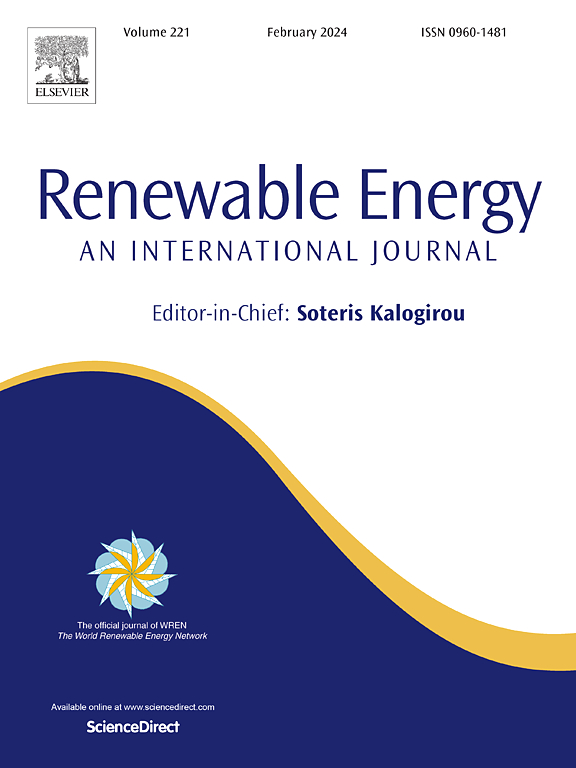基于多尺度特征识别的风电场尾流数据驱动建模
IF 9.1
1区 工程技术
Q1 ENERGY & FUELS
引用次数: 0
摘要
考虑尾流效应的风流发展的准确和有效预测对于风电场布局和功率预测至关重要。现有的方法大致可分为物理测量、数值模拟、基于物理的建模和数据驱动的建模。前两种方法在时间和资源方面成本较高,第三种方法由于物理模型的限制而精度较低,而最后一种方法利用了大量可用的高质量数据,并且越来越受欢迎。本研究以视频帧插值为灵感,基于相似性原理,利用多尺度特征识别技术,提出了一种快速的风电场尾流数据驱动建模方法。该方法将风电场数据转换为图像,并通过使用尺度不变特征变换(SIFT)和动态时间翘曲(DTW)方法从一组有限的尾流图像中识别、匹配和插值特征来预测尾流。为了验证该方法的有效性,对6个典型案例进行了评估,包括具有不同涡轮机间距、不同涡轮机尺寸、不同间距和尺寸变化组合、不同涡轮机数量以及不同程度风向失调的小型风电场。平均绝对百分比误差(MAPE)在0.68%到2.28%之间。由于该方法能够灵活地计算二维和三维尾流场,因此在二维尾流场足以满足工业需求的情况下,该方法比大涡模拟(LES)和Meteodyn WT具有独特的计算效率优势。因此,该方法可用于扩展尾流数据库,服务于风电场设计、功率预测等,替代测量、数值模拟和基于物理的建模,平衡效率和精度。本文章由计算机程序翻译,如有差异,请以英文原文为准。
Data-driven modeling of wind farm wake flow based on multi-scale feature recognition
Accurate and efficient predictions of wind flow developments with wake effects accounted are crucial for wind farm layouts and power forecasting. Existing methods can be broadly classified as physical measurement, numerical simulations, physics-based modeling, and data-driven modeling. The first two is of high cost in terms of time and resources, the third suffers from low accuracy due to limited physics modeled, while the last one takes advantage of the large amount of high-quality data available and has become increasingly popular. This study proposes a rapid data-driven modeling method for wind farm wake flow, inspired by video frame interpolation and based on the principle of similarity, which utilizes a multi-scale feature recognition technique. The method transforms wind farm field data into images and predicts wake flow by identifying, matching, and interpolating features from a limited set of wake flow images using the Scale-Invariant Feature Transform (SIFT) and Dynamic Time Warping (DTW) approaches. To demonstrate the effectiveness of the proposed method, six representative cases were evaluated, encompassing mini wind farms with varying turbine spacings, different turbine sizes, combinations of spacing and size variations, different numbers of turbines, and various degrees of wind direction misalignment. A Mean Absolute Percentage Error (MAPE) ranging from 0.68% to 2.28% is achieved. Due to its ability to flexibly compute both 2D and 3D wake flow fields, the proposed method offers unique computational efficiency advantages over Large Eddy Simulation (LES) and Meteodyn WT in scenarios where two-dimensional wake flow fields are sufficient to meet industrial requirements. Therefore, this method can be employed for the extension of the wake flow database serving wind farm design, power prediction, etc., as an alternative to measurements, numerical simulation, and physics-based modeling, balancing efficiency and accuracy.
求助全文
通过发布文献求助,成功后即可免费获取论文全文。
去求助
来源期刊

Renewable Energy
工程技术-能源与燃料
CiteScore
18.40
自引率
9.20%
发文量
1955
审稿时长
6.6 months
期刊介绍:
Renewable Energy journal is dedicated to advancing knowledge and disseminating insights on various topics and technologies within renewable energy systems and components. Our mission is to support researchers, engineers, economists, manufacturers, NGOs, associations, and societies in staying updated on new developments in their respective fields and applying alternative energy solutions to current practices.
As an international, multidisciplinary journal in renewable energy engineering and research, we strive to be a premier peer-reviewed platform and a trusted source of original research and reviews in the field of renewable energy. Join us in our endeavor to drive innovation and progress in sustainable energy solutions.
 求助内容:
求助内容: 应助结果提醒方式:
应助结果提醒方式:


